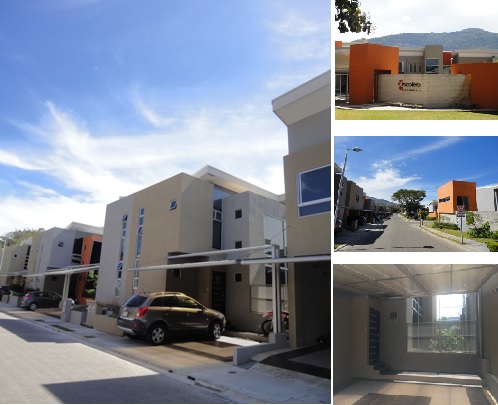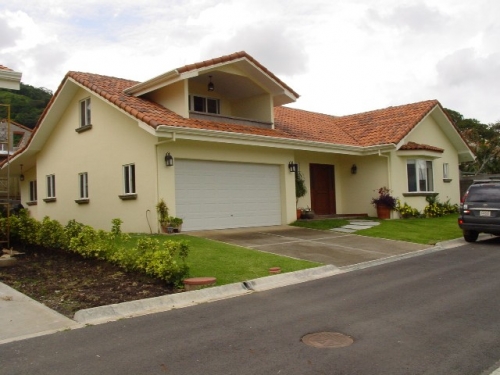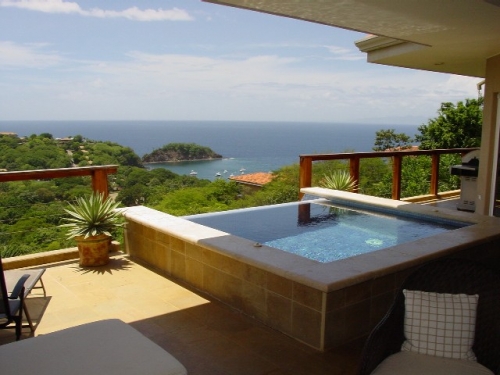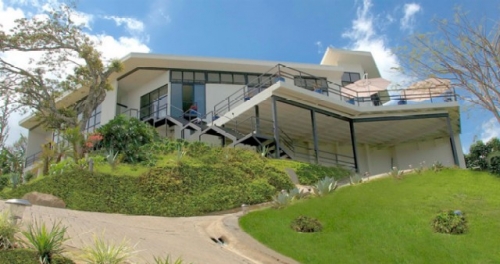Costa Rica Guide
Costa Rica Real Estate
List your property today!
Inclusion of real estate listings at Costa Rica Guide is
absolutely free of charge.
Featured Properties
Costa Rica Guide - Costa Rica Real Estate
Central Pacific Region - Costa Rica Country Profile
Costa Rica’s central Pacific coast is a year-round tropical playground. Its evergreen forests meet warm Pacific surf on sandy beaches to provide a unique setting that Costa Ricans and foreign travelers discovered long ago.
The Pacific port town of Puntarenas, which sits on a narrow finger of sand jutting into the Gulf of Nicoya, marks the transitional zone and provides access to the country’s mid Pacific. This territory is composed of a combination of private reserves and active villages. Activities include sports fishing, surfing at its best and many other activities ranging from forest oriented to deep sea adventures.
An ancient fishing port, the dark beaches of this sleepy town attract many Costa Rican tourists escaping the rigors of city life. From Puntarenas one can explore several gulf islands, charter fishing trips and catch ferries to the Nicoya Peninsula.
A few miles south of Puntarenas is the port of Caldera. Here is where the Pacific ocean liners dock to release their passengers on an idyllic jaunt through Costa Rica. Although tours to all parts of the country are available from here, most stay in the area to take advantage of the well developed infrastructure and multitude of activities available along this coast.
The coastal road south from Puntarenas crosses rolling terrain as it wanders part way up the mountainside to Orotina. This a good place for a short break before heading back down to the central Pacific beaches. The intersection on the main road has several restaurants and shops to buy drinks, snacks and fruits.
There’s a lot to do along this part of Costa Rica’s Pacific coast, and not all of it has to do with beaches and water. Surely some of Costa Rica’s best beaches are here, but the rivers and mountains behind the beaches hold a wealth of activities for the adventurous traveler.
Montezuma: the curious blend
Across the gulf from Puntarenas, on the southern tip of the Nicoya Peninsula, lies the village of Montezuma. This bohemian settlement has beautiful scenic beaches and superb gourmet restaurants as well as facilities and services suitable to the most demanding tastes.
Take the Paquera Ferry, departing several times everyday, and enjoy an hour and a half trip over the waters of the Nicoya Gulf. Once in Paquera, another hour by road will get you to Montezuma.
Foreign settlers first came to this area in the 1950s. Since then they have been increasingly active, building the village which today features all services and gathers an international community fully engaged in the protection of nature.
As with many other tourist beach destinations in Costa Rica, Montezuma has been favored by foreign investment. The difference is the fact that most foreigners living and investing here are very much committed to bohemian life and the development of art. This, along with the contribution of local artists who adopted Montezuma as their own, has benefited the area tremendously.
As if beauty and bohemian extravaganza weren’t enough, Montezuma is the only beach zone in the entire country where visitors can enjoy a vineyard tour, on a wild experience that ends up with a torch ceremony at sunset. This event very much reveals the general atmosphere in Montezuma.
Like other places in the region, enjoy horseback riding, diving or ocean tours to nearby islands. If you have at least two or three days to spare in Costa Rica, think about visiting Montezuma. Either by land or by air, Montezuma is very accessible and worth the visit.
Despite its natural scenic impact, Montezuma is cozy and intimate; a village that voluntarily wants to keep a low profile but nevertheless active and energetic and that’s the curious blend.
The transitional zone
Heading south from Puntarenas on the coastal road, the first stop is the bridge over The Grande de Tarcoles River. You can’t miss it. It is very long, there are shops at the approach, and you are likely to see cars stopped and people on foot wandering back and forth across the bridge, looking down toward the river. They are trying to spot a few of the resident crocodiles. If you just can’t seem to get close enough for a good look, drive on past the bridge and take the right turn to the village of Tarcoles. Here you can catch a pontoon boat ride with Jungle Crocodile Safari up the Grande de Tarcoles River and into the heart of Crocodile Country.
The central Pacific has many important national and private protected areas. These pristine green zones provide sanctuary for many endan gered species. The two most well-known areas, Carara Biological Reserve and Manuel Antonio National Park, are readily accessible natural laboratories that nature lovers enjoy immensely.
Carara Biological Reserve borders the Tarcoles River. This transitional zone encompasses several ecosystems and harbors an incredible variety of wildlife including the largest population of scarlet macaws in Costa Rica. These brilliantly colored birds are in great danger of extinction due primarily to nest poaching (the young are highly prized on the international market) and habitat loss.
Two entrances along the highway provide access to two hiking areas. The river trail passes through marshlands and past a lagoon formed from an abandoned river meander. This is an exceptional area for spotting waterfowl. The second, shorter trail is a good introduction to transitional evergreen forests. Along with the more than 750 plant species identified here, some representative animals include white-tailed deer, the rare two-toed sloth, margay cat, kinkajou, ocelot and spider monkey.
Just past Carara on the left is a road leading up the mountainside. Eight kilometers (be sure to go the full eight kilometers) through rich forests and past breathtaking views brings you to a small tourist complex called La Catarata. Here you can take a four-hour trek on horseback through a private, reforested cattle ranch to a magnificent waterfall. Along the way you’ll see several expansive vistas and you’re likely to spot scarlet macaws, toucans and monkeys.
Beaches and Fun
Next stop is Jaco Beach, where the Ticos traditionally go to play in the sun. There’s plenty of infrastructure, shopping, nightlife and accommodations to provide anything one might want in a beach vacation. A plethora of activities abound and tours can be arranged to most other parts of the country in addition to the broad selection available in the surrounding area.
The road follows the coast out of Jaco and provides spectacular scenery along the beaches. At the top of the hill is a great spot for a final look back at Jaco. A little further is a perfect view looking down on the long, black expanse of Playa Hermosa.
There is a lot of uncrowded beach along this stretch. Many gravel roads provide easy access to these oases with names like Esterillos Oeste, Bejuco and Palma. They are characterized by grand expanses of empty beach and minimal established infrastructure erected by a few local families, a small restaurant or two, or a couple of seaside cabins.
Further along, Parrita is a traditional gas and rest stop on the way to Quepos, a place to brush off the dust of the kilometers traversing the African oil palm groves.
Damas Island
Driving on from Parrita there is an obligatory stop at Damas Island, a delicate strip of land broken and separated from the mainland, reachable either from the ocean or from the land by passing through the narrow estuary that sets this world apart. It is a natural phenomenon, stressed by a recent earthquake that divided the island into two sections.
Located just three miles before the town of Quepos and the resort area of Manuel Antonio National Park, the estuary opens a door to a world where animals still live in natural ways.
The environment has been well preserved and the calm waters of the canals make the area an adventurous territory to be explored.
Sailing the canals
Visiting Damas Island and navigating the canals of the reserve is a must for all visitors to the area. The tour can be arranged at any of the fine hotels near Manuel Antonio National Park or from Quepos. Several boatmen operate at Pueblo Nuevo’s dock, so transportation and a guide can be arranged right there as well.
Tour guides are usually from the region. They are wonderfully friendly and know the area first hand, making the entire tour experience safe and educational.
Manuel Antonio National Park
Manuel Antonio National Park is one of the most beautiful parks in the country. It is also the most popular, with locals and foreigners alike. The hilly evergreen forest providing natural shade from the tropical sun lines two gorgeous white beaches sloping to the gentle surf. Several trails lead through dense jungle growth to hidden sandy coves and magnificent lookouts over the ocean and beaches.
Despite its small size and great popularity, Manuel Antonio manages to remain one of the premier nature spots in the country. The mountains literally meet the sea here and the ecosystem is teeming with land, sea and air species. If there is one place to visit in this country and be assured of seeing animals in the wild, this is it.
Just a couple hours walking the park’s trails are likely to present various colorful and majestic birds, white faced monkeys, two-and three-toed sloths, coatis, pacas, brilliantly colored land crabs, a variety of multi-hued butterflies, and interesting insects. The endangered squirrel monkey, endemic to Costa Rica, is also frequently seen. In all, over 100 species of animals and nearly 200 species of birds have been identified in this park.
The area between Quepos and Manuel Antonio has been commercialized with dozens of hotels and restaurants offering visitors a wide variety of accommodations and dining choices. Camping is available in some areas near the park and dozens of roadside vendors offer all manner of food, drinks and souvenirs.
The above information is courtesy of Costa Rica Institute of Tourism (ICT).






